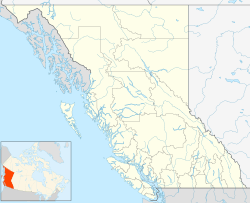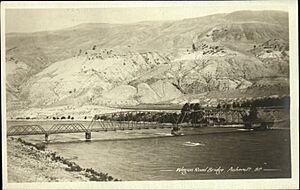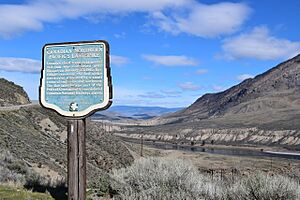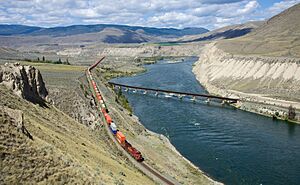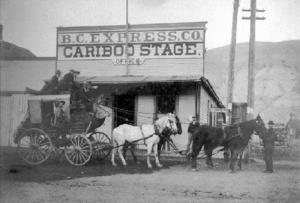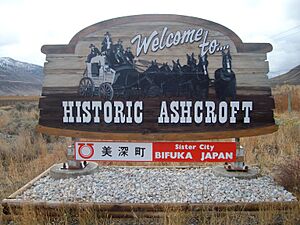Ashcroft, British Columbia facts for kids
Quick facts for kids
Ashcroft
|
|
|---|---|
|
Village
|
|
| The Corporation of the Village of Ashcroft |
|
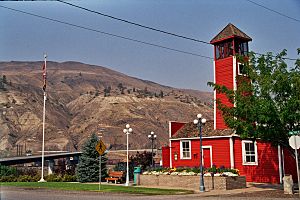
Fire hall from 1919, Ashcroft, 2006
|
|
| Country | Canada |
| Province | British Columbia |
| Region | Thompson Country |
| Regional District | Thompson-Nicola |
| Founded | 1883 |
| Incorporated as a Village | 1952 |
| Government | |
| • Type | Elected village council |
| Area | |
| • Total | 50.86 km2 (19.64 sq mi) |
| Elevation | 335.2 m (1,099.7 ft) |
| Population
(2021)
|
|
| • Total | 1,670 |
| • Density | 32.84/km2 (85.04/sq mi) |
| Time zone | UTC−8 (PST) |
| • Summer (DST) | UTC−7 (PDT) |
| Postal Code |
V0K 1A0
|
| Area code(s) | 250, 778, 236, & 672 |
| Highways | |
| Waterways | Thompson River |
Ashcroft is a small village in British Columbia, Canada. It is located in the south-central part of the province, right next to the Thompson River. You can find Ashcroft east of BC Highway 1 and on BC Highway 97C. By road, it is about 45 kilometers (28 miles) north of Spences Bridge and 11 kilometers (7 miles) south of Cache Creek.
Contents
Early History of Ashcroft
Ashcroft was started in 1862 by two brothers, Clement Francis Cornwall and Henry Pennant Cornwall. They opened a roadhouse in 1863. A roadhouse was like a hotel for travelers on the Cariboo Road. The name Ashcroft was first used for their farm in 1863.
In 1868, John Christopher Barnes and E. William Brink started a ranch on the east side of the river. Later, in 1877, Jerome Harper built a mill to grind grain on the west side. These early settlers worked together to build a wagon road from the mill to the Cariboo Road.
In the early 1880s, John Barnes and Oliver Evans built a small hotel by the ferry crossing. In 1884, Barnes moved the hotel and planned out the town of Ashcroft on his ranch land.
Bridges and Ferries
Getting across the Thompson River was important for Ashcroft. In the late 1860s, John Barnes set up a ferry. The government took over the ferry from 1883 to 1885.
A bridge was built across the river between 1884 and 1886. It was about 201 meters (661 feet) long. But in 1894, a big flood washed the bridge away! People used a rowboat until a cable ferry was put in place. A new bridge was finished in 1895.
In 1906, during work to replace the bridge, three construction workers drowned when their boat flipped over. A new bridge opened in 1907. Another bridge was built in 1916–17 after the previous one was washed out.
In 1929, the bridge almost caught fire. Then, in 1932, a strong new bridge made of concrete and steel was completed. It was about 238 meters (780 feet) long. The old, rotting bridge was blown up with dynamite.
The current bridge in Ashcroft opened in 1991.
Railways in Ashcroft
Ashcroft became an important railway stop, with two major Canadian railway companies passing through.
Canadian Pacific Railway (CP)
In 1884, the Canadian Pacific Railway (CP) built a station and a bunkhouse for workers in Ashcroft. The railway line reached Ashcroft in December of that year. The station was first called St. Cloud, but the name Ashcroft Station became official when the post office opened in 1886.
The CP station in Ashcroft was very busy. In 1896, it sold over 16,000 passenger tickets! In 1899, a new, larger station building was built. Over the years, there were a few train accidents, like derailments caused by slides or washouts.
The CP station was replaced again in 1960 and then in 1987. The current station building is a mobile one, put in place around 2020.
Canadian National Railway (CN)
The Canadian Northern Railway (CNoR), which later became part of the Canadian National Railway (CN), also built tracks through Ashcroft. In 1912, a long tunnel was finished near Black Canyon. By 1913, two bridges were built across the Thompson River northeast of Ashcroft. Another bridge to the southwest was completed in 1914.
The CN railway line reached the Ashcroft area in January 1915. In 1920, a CN passenger train hit a rockslide, and the locomotive derailed. Sadly, the fireman died in this accident.
VIA Rail
Today, Via Rail's passenger train, called "The Canadian," makes a stop in Ashcroft. It's a "flag stop," which means the train will only stop if someone wants to get on or off.
Ashcroft Community Life
Ashcroft has a rich history as a community. In 1886, BC Express (BCX) moved its main office to Ashcroft. This made Ashcroft "Mile 0" on the Cariboo Road. Travelers and goods would switch from trains to stagecoaches or wagons here to continue their journey north.
The town grew quickly. By 1889, Ashcroft had hotels and Chinese businesses. The town hall, which later became an opera house, opened that year.
Ashcroft became famous for its potatoes, which were known across Canada for many years! Churches were built, including Anglican (1891), Presbyterian (1892), and Methodist (1897). A newspaper, The BC Mining Journal, started in 1895 and was renamed the Ashcroft Journal in 1899.
In 1898, the town got electricity and a water supply system. A firehall and a bank also opened. Ashcroft was a lively place, with big annual balls and agricultural fairs. By 1899, the population was over 600 people.
In 1901, a telegraph line from Ashcroft all the way to the Yukon was completed. By 1905, Ashcroft had three hotels, nine stores, and government buildings. It was a busy center for transportation, ranches, and mines.
A hospital, called Lady Minto, opened in 1913. However, in 1914, the completion of another railway line (the Grand Trunk Pacific Railway) meant less traffic for BCX in Ashcroft. This caused businesses to slow down and the local population to shrink.
In 1916, a big fire destroyed five blocks of Ashcroft, including Chinatown and several hotels. The Ashcroft Hotel was rebuilt.
From 1925 to 1957, the Ashcroft Cannery produced tomato products. Chinese gardeners were very important to the tomato industry in the area.
Ashcroft officially became a village in 1952. The Roman Catholic church was built in 1956. The local electricity system was connected to the main power grid in 1954.
In 1962, copper mining became important for the economy. Later, these mines joined together to form the Highland Valley Copper mine.
In 1972, a new, larger hospital opened in North Ashcroft. Sadly, several fires affected the town in the 1970s, destroying buildings like the Ashcroft Hotel and the arena.
In 1983, Ashcroft celebrated its 100th birthday! In 1986, the new Coquihalla Highway opened, which changed traffic patterns and meant fewer cars passed through Ashcroft on BC Highway 1.
Ashcroft is also a popular place for people to retire. Emergency services include a volunteer fire department and the RCMP.
Education in Ashcroft
The first school in Ashcroft opened in 1886 in a former railway bunkhouse. After it was abandoned, it burned down in 1916. A second school was built in 1889–90 and later expanded.
Around 1900, a new two-story school building was built. In 1922, the Lady Byng School opened, teaching students from grades 1 to 12.
In 1945, the school system was reorganized, and Ashcroft became School District 30. A new Ashcroft High School opened in 1950.
In 1962, Ashcroft Elementary School opened for younger students. This school was expanded over the years but closed in 2015.
A new Ashcroft Secondary School opened in 1973. In 1996, the school districts joined together to form School District 74 Gold Trail. In 2015, the high school became the Desert Sands Community School, teaching all grades from kindergarten to 12.
In 1993, the University College of the Cariboo (UCC) opened a branch inside the high school, offering college-level courses.
Famous People from Ashcroft
Many notable people have lived in or were born in Ashcroft:
- Eric Brewer (born 1979), an ice hockey player.
- Jean-Jacques Caux, also known as Cataline (around 1830–1922), who operated pack trains.
- Ralph Chetwynd (1890–1957), a businessman and politician.
- Stuart Alexander Henderson (1863–1945), a politician and lawyer.
- Kenneth Durward Houghton (1925–2005), a superior court judge.
- Mervyn Huston (1912–2001), a pharmacologist.
- Alexander Lucas (1852–1942), a politician.
- William Garland McQuarrie (1876–1943), a politician.
- Denis Murphy (1870–1947), a politician and judge.
- James Murphy (1872–1921), a lawyer and politician.
- William Cameron Murphy (1905–1961), a lawyer and military officer.
- Frank Oberle Jr. (born 1957), a politician.
- Don Paquette (1939–2017), a football player.
- Casey Pierro-Zabotel (born 1988), an ice hockey player.
- Barbara Roden (born 1963), a publisher and politician.
- Charles Augustus Semlin (1836–1927), a politician.
- T. David Somerville (1915–2011), a religious leader.
- Jackie Tegart (born 1956), a politician.
- Stephen Tingley (1839–1915), a capitalist.
- John Owen Wilson (1898–1985), a superior court judge.
Modern Ashcroft
In 2000, the Thompson Valley Savings Credit Union took over the Bank of Montreal branch in Ashcroft. Heritage Place Park also opened that year. In 2001, a fire damaged some historic wooden buildings downtown.
In 2004, Ashcroft's town limits expanded to include the Ashcroft Ranch. Since 2007, artist Marina Papais has been creating beautiful stained-glass artworks displayed around the village.
In 2008, BC Transit started a bus service connecting Clinton, Cache Creek, and Ashcroft. Also in 2008, plans to build a new landfill on the Ashcroft Ranch site were stopped due to opposition from First Nations groups.
Ashcroft has a "sister town" in Japan called Bifuka, Hokkaido, since 1994. Delegations from each town visit each other.
When the old Ashcroft Elementary School closed in 2015, the building was turned into a community center called "The HUB." In 2016, the post office, built in 1980, was renovated inside.
In 2017, the Elephant Hill wildfire burned on the east side of the river, affecting a large area near Ashcroft. In 2018, Greyhound bus service stopped its route through Ashcroft.
In 2021, the Legacy Park Campground upgraded its facilities. In 2022, a new urgent and primary care center opened at the hospital, helping people get quick medical attention.
Population and Climate
In 2021, Ashcroft had a population of 1,670 people. It is a small village with a land area of about 50.86 square kilometers (19.64 square miles).
Ashcroft has a dry, semi-arid climate. This means it gets very hot in the summer and has short, mild winters with light snow. Ashcroft often has some of the hottest temperatures in British Columbia. It even holds the record for the second highest temperature ever recorded in Canada! Some parts of Ashcroft along the Thompson River gorge are so dry that they are considered a "pocket desert," which is the only true desert area in Canada.
| Climate data for Ashcroft | |||||||||||||
|---|---|---|---|---|---|---|---|---|---|---|---|---|---|
| Month | Jan | Feb | Mar | Apr | May | Jun | Jul | Aug | Sep | Oct | Nov | Dec | Year |
| Record high °C (°F) | 13.8 (56.8) |
16.0 (60.8) |
24.5 (76.1) |
31.3 (88.3) |
34.6 (94.3) |
48.1 (118.6) |
42.1 (107.8) |
41.1 (106.0) |
37.5 (99.5) |
28.2 (82.8) |
23.7 (74.7) |
15.6 (60.1) |
48.1 (118.6) |
| Mean daily maximum °C (°F) | −0.5 (31.1) |
4.0 (39.2) |
10.0 (50.0) |
15.8 (60.4) |
20.7 (69.3) |
24.6 (76.3) |
28.0 (82.4) |
27.6 (81.7) |
21.6 (70.9) |
14.2 (57.6) |
5.4 (41.7) |
0.4 (32.7) |
14.3 (57.8) |
| Daily mean °C (°F) | −3.9 (25.0) |
−0.1 (31.8) |
4.7 (40.5) |
9.3 (48.7) |
13.9 (57.0) |
18.0 (64.4) |
20.8 (69.4) |
20.5 (68.9) |
15.2 (59.4) |
9.2 (48.6) |
2.2 (36.0) |
−2.5 (27.5) |
8.9 (48.1) |
| Mean daily minimum °C (°F) | −7.3 (18.9) |
−4.1 (24.6) |
−0.6 (30.9) |
2.9 (37.2) |
7.2 (45.0) |
11.4 (52.5) |
13.7 (56.7) |
13.5 (56.3) |
8.9 (48.0) |
4.2 (39.6) |
−1.0 (30.2) |
−5.4 (22.3) |
3.6 (38.5) |
| Record low °C (°F) | −24.4 (−11.9) |
−21.7 (−7.1) |
−16.8 (1.8) |
−8.1 (17.4) |
−0.6 (30.9) |
4.5 (40.1) |
8.5 (47.3) |
6.1 (43.0) |
1.7 (35.1) |
−5.0 (23.0) |
−21.1 (−6.0) |
−28.8 (−19.8) |
−28.8 (−19.8) |
| Average precipitation mm (inches) | 54 (2.1) |
33 (1.3) |
39 (1.5) |
33 (1.3) |
44 (1.7) |
50 (2.0) |
41 (1.6) |
28 (1.1) |
36 (1.4) |
50 (2.0) |
72 (2.8) |
61 (2.4) |
541 (21.2) |
| Source 1: Environment and Climate Change Canada | |||||||||||||
| Source 2: Climate-data.org (normals) | |||||||||||||
Filming Location
Ashcroft and the surrounding area have been used as a filming location for many movies and TV shows, including:
- Gold Trails and Ghost Towns (1988)
- Sky High (1989 Disney film)
- Cadence (1990)
- Bird on a Wire (1990)
- The X-Files (1993 TV series)
- Double Cross (1994)
- Eyes of a Cowboy (1998 TV mini-series)
- The Pick-up (1999 short film)
- By Dawn's Early Light (2001 TV movie)
- Lola (2001)
- Flower & Garnet (2002)
- Traffic (2004 mini-series)
- The Sisterhood of the Traveling Pants (2005)
- An Unfinished Life (2005)
- Miss Texas (2005 TV movie)
- Partition (2007)
- Afghan Knights (2007)
- Centigrade (2007 short film)
- Shooter (2007)
- Joyride 2: Dead Ahead (2008)
- The Andromeda Strain (2008 mini-series)
- 2012 (2009)
- Alien Trespass (2009)
- Rain Down (2010)
- Thirst (2010)
- The A-Team (2010)
- Flicka 2 (2010)
- Afghan Luke (2011)
- King David (2012 TV mini-series)
- The Walk (2013 short film)
- The X-Files (2016 TV Series), Episode: "My Struggle"
- Monster Trucks (2016)
- Tomato Red (2017)
- Juggernaut (2017)
- A Dog's Way Home (2019)
- Red Snow (2019)
- The Twilight Zone (2020)
- The Stand (2020)
- Bullet Proof (also known as Death Pursuit) (2022)


